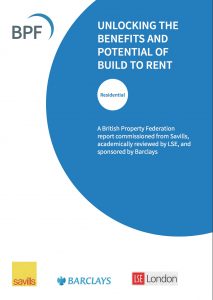
We understand that the UK needs to increase housing supply from around 200,000 net additions to 300,000 homes per year to identify housing needs of 1.5m homes in the next five years (see our previous report with the Town & Country Planning Association). We have identified Build to Rent (BTR) as a model that can help address and meet these goals (see our previous report with Future of London). The task before us then is to clarify the potential of BTR by identifying specific policies that can yield great levels of supply from already expanding BTR investments. We provided an independent role in the collection and analysis of data for this research conducted by Savills, and sponsored by Barclays, which endeavours to make clear which specific policies can help nourish the BTR sector while it is in its infancy phase.
The report provides a context and rationale for the need to nourish the BTR sector, as well as its barriers to investment, specific policies and programmes, the market size and its potential, the current supply, management, and prospects for the market. Also identified in the report, through direct stakeholder investment, are perspectives on how the sector is developing and on its key challenges in its progression. Stakeholders also identified, the report claims, additionality benefits of BTR as well as the conditions that are needed in order for additionality benefits to come through. Click here to read the report and the entire executive summary.
The reports sets out overall conclusions in its Chapter 10, outlining specific policies that are effective in overcoming market failures, delivering new market homes, and how to maximise positive externalities. These are the key bullet points quoted as outlined in the report:
- Clarifying the role of DMR as meeting affordable housing requirements for BTR developments;
- Changing planning regulations and standards for BTR developments;
- Continuation of public sector development loans for BTR;
- Extension by time and scope of the PRS Debt Guarantee scheme
- Planning Preference for BTR on Large Sites;
- Exempt large scale landlords from the 3% SDLT surcharge;
- Zero-rate VAT on repairs and management to make BTR more competitive.
The full report can be accessed here.
This is a quoted list of the 10 specific recommendations made in the report:
- Build to Rent (BTR) Definition – A statutory planning definition will help accelerate and maximise delivery of homes. It is a prerequisite for implementing other planning policies and to ensure consistency of interpretation across local authorities.
- Discounted Market Rent – National policy such as the National Planning Policy Framework (NPPF) should outline that discounted market rent is an acceptable form of affordable housing for BTR where there is a requirement to provide affordable housing in the same block as the private rented units.
- Covenants and Clawbacks – Provide guidance within National Planning Policy Guidance (NPPG) on the use of covenants to ensure that in circumstances where there has been a concession to enhance viability in terms of the affordable housing provision local authorities are using consistent clawback mechanisms.
- Planning Preference for Build-to-Rent on Large Sites – National and local guidance should encourage local planning authorities to recognise the significant additionality benefits of BTR when working with developers to bring forward phases of large sites so that they are built out earlier than otherwise planned, alongside the early build-for-sale phases.
- Design and Space Standards – National policies and guidance should promote greater flexibility on design and space standards in high density, town centre, urban locations with good transport accessibility. It should offer guidance for local authorities on the key factors (car parking, unit mix, unit size, single aspect, units per core) that can impact on the viability of Build-to-Rent.
- Government Debt Guarantee for Private Rented Sector (PRS) – The Government should consider extending the £3.5bn Debt Guarantee for PRS in terms of time and scope to give confidence to lenders in the space that there will be investment / end buyer finance available to help the market scale up and mature.
- Home Builders Fund – The HCA should use an explicit tranche of the Home Builders Fund for PRS to demonstrate the Government’s continued commitment to delivering good quality rented housing that is owned and managed by professional investors.
- Market Information and Transparency – Both the HCA and Venn have access to a useful range of information and data on the new BTR sector which would be helpful to lenders underwriting transactions if the data were made available in aggregate form.
- SDLT Amendments – Exempt large scale investors from the 3% SDLT surcharge. There appears to be precedents set by the Scottish Governments decision to exempt institutional when the surcharge was introduced and this should be investigated further.
- VAT Amendments – Changes to the VAT regime in terms of zero-rating the costs of repairs and maintenance would improve the viability of a large number of BTR sites. These changes should be considered post-Brexit.





